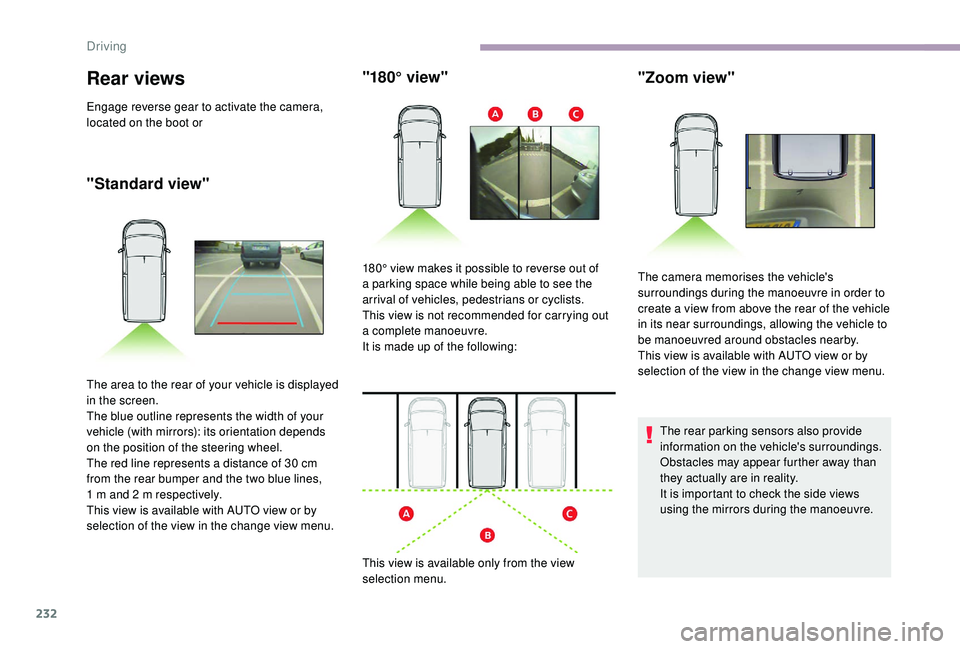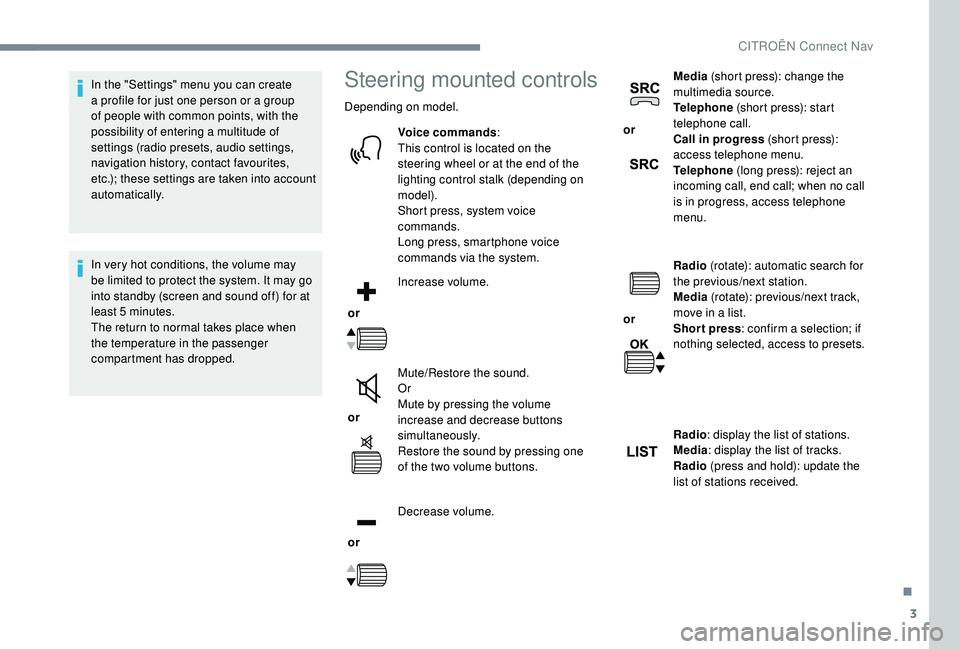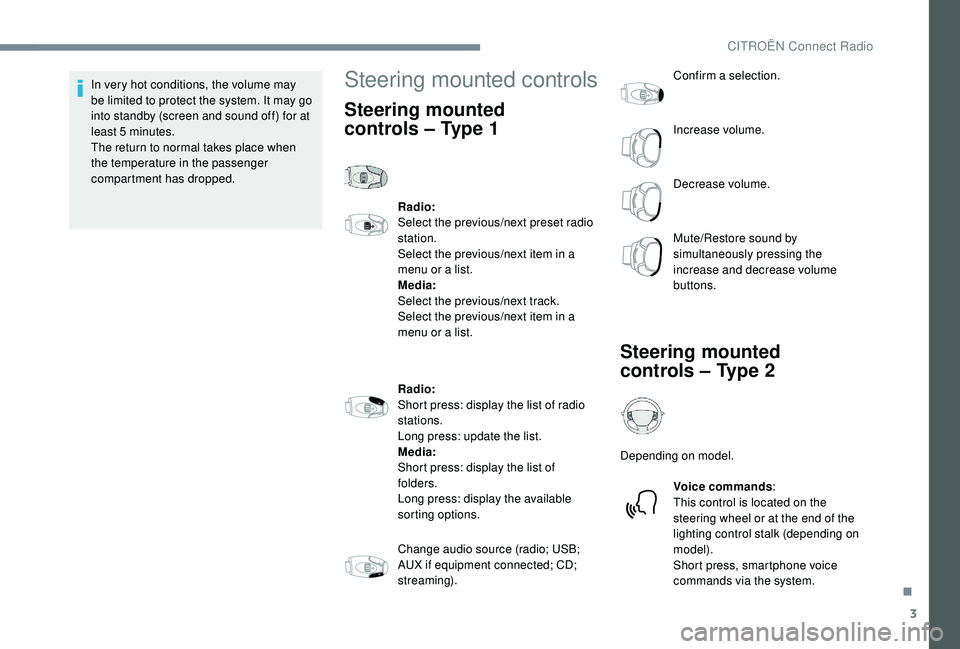2018 CITROEN DISPATCH SPACETOURER change wheel
[x] Cancel search: change wheelPage 234 of 400

232
Rear views
Engage reverse gear to activate the camera,
located on the boot or
"Standard view""180° view"
The area to the rear of your vehicle is displayed
in the screen.
The blue outline represents the width of your
vehicle (with mirrors): its orientation depends
on the position of the steering wheel.
The red line represents a distance of 30
cm
from the rear bumper and the two blue lines,
1
m and 2 m respectively.
This view is available with AUTO view or by
selection of the view in the change view menu. 180° view makes it possible to reverse out of
a parking space while being able to see the
arrival of vehicles, pedestrians or cyclists.
This view is not recommended for carrying out
a complete manoeuvre.
It is made up of the following:
This view is available only from the view
selection menu.
The rear parking sensors also provide
information on the vehicle's surroundings.
Obstacles may appear further away than
they actually are in reality.
It is important to check the side views
using the mirrors during the manoeuvre.
"Zoom view"
The camera memorises the vehicle's
surroundings during the manoeuvre in order to
create a view from above the rear of the vehicle
in its near surroundings, allowing the vehicle to
be manoeuvred around obstacles nearby.
This view is available with AUTO view or by
selection of the view in the change view menu.
Driving
Page 236 of 400

234
Under-inflation detection
This system automatically monitors the tyre
pressure while driving.
The system monitors the pressure in all four
tyres, once the vehicle is moving.
It compares the information given by the
wheel speed sensors with reference values,
which must be reinitialised after ever y tyre
pressure adjustment or wheel change.
The system triggers an alert as soon as it
detects a drop in the pressure of one or more
tyres.
The tyre under-inflation detection system
does not replace the need for vigilance on
the part of the driver.
This system still requires you to check
the tyre inflation pressures (including
the spare wheel) every month as well as
before a long journey.
Driving with under-inflated tyres impairs
handling, extends braking distances and
causes early tyre wear, particularly in
adverse conditions (heavy loads, high
speeds, long journeys). Driving with under-inflated tyres
increases fuel consumption.
The tyre pressure specifications for your
vehicle can be found on the tyre pressure
label.
For more information on the
Identification markings , refer to the
corresponding section.
Tyre pressures should be checked when
the tyres are "cold" (vehicle stopped for
1
hour or after a journey of less than
6
miles (10 km) at moderate speeds).
Other wise (when hot), add 0.3
bar to the
pressures shown on the label.
Snow chains
The system does not have to be
reinitialised after fitting or removing snow
chains.
Spare wheel
The steel spare wheel does not have an
under-inflation detection sensor.
Under-inflation alert
This warning is indicated by fixed
illumination of the lamp, an audible
signal and, depending on the
equipment installed, a message
displayed on the screen.
F
R
educe speed immediately, avoid excessive
steering movements and sudden braking.
F
S
top the vehicle as soon as it is safe to do
so.
The loss of pressure detected does not
always cause visible bulging of the tyre.
Do not satisfy yourself with just a visual
check.
F
I
n the event of a puncture, use the
temporary puncture repair kit or the spare
wheel (depending on equipment),
or
F
i
f you have a compressor, such as the one
in the temporary puncture repair kit, check
the pressures of the four tyres when cold,
or
F
i
f it is not possible to make this check
immediately, drive carefully at reduced
speed.
Driving
Page 266 of 400

264
For more information on To w i n g, refer to
the corresponding section.
All of these tools are specific to your
vehicle and can vary according to the level
of equipment.
Do not use them for any other purposes.
The jack must only be used to change
a wheel with a damaged or punctured tyre.
Do not use any jack other than the one
supplied with this vehicle.
If the vehicle does not have its original
jack, contact a CITROËN dealer or a
qualified workshop to obtain the correct
jack for it.
The jack meets European standards,
as defined in the Machinery Directive
2006/42/EC.
The jack does not require any
maintenance.Access to the spare wheel
F Access to the spare wheel is from the rear.
F O pen the side-hinged rear doors or the
tailgate according to the configuration of
your vehicle.
To avoid any unwanted opening of the
electric side door(s), deactivate the
" Hands-Free Tailgate Access " function
in the vehicle configuration menu.
For more information on the Hands-
free sliding side door , refer to the
corresponding section. F
I
f your vehicle is fitted with a towbar, raise
the rear of the vehicle using the jack (must
be at jacking point B ) to allow sufficient
space to remove the spare wheel.
Removing
F Access the carrier bolt, located on the rear door sill.
In the event of a breakdown
Page 267 of 400

265
F Turn the bolt anti-clockwise using the wheelbrace (about 14 turns) until the carrier
is low enough to allow the carrier hook to be
disengaged.
F
R
elease the carrier from the hook, take the
spare wheel and place it next to the wheel
to be changed.
RefittingTyre in the carrier
If you want to change the size of the tyre on the
spare wheel, follow the instructions below.
A punctured tyre of size 215
or 225 can be
placed in the carrier.
F
P
osition the wheel facing the carrier.
F
P
rogressively return the wheel to the carrier
by pushing alternately from left to right until
it is clear of the hook fixing area.
F
E
ngage the carrier on the hook, then tighten
the bolt using the wheelbrace until the bolt
is fully home.
Original tyre size XS - M XL
215/65
R16 Placing a 225
wheel in the
carrier is prohibited.
There is no restriction.
215/60
R17
215/60
R17
M&S
2 2 5 / 5 5
R17 Placing a 215
wheel in the
carrier is not recommended (risk of noise).
8
In the event of a breakdown
Page 268 of 400

266
Removing a wheel
Parking the vehicle
Park the vehicle where it does not block
traffic: the ground must be level, stable
and non-slippery.
With a manual gearbox, engage first gear
then switch off the ignition to block the
wheels.
With an automatic gearbox, place the gear
selector to position P then switch off the
ignition to block the wheels.
With an electronic gearbox, place the gear
selector to position A then switch off the
ignition to block the wheels.
Apply the parking brake and check that
the warning lamp is on in the instrument
panel.
The passengers must get out of the
vehicle and wait where they are safe.
Never go underneath a vehicle raised
using a jack; use an axle stand.F
P
lace the foot of the jack on the ground and
ensure that it is directly below the A or B
jacking point provided on the underbody,
whichever is closest to the wheel to be
changed.
Do not use:
-
t
he jack for any other purpose than
lifting the vehicle,
-
a j
ack other than the one supplied by
the manufacturer.
F
I
f your vehicle has steel wheels, remove the
hub cap using tool 3 .
F
I
f your vehicle has alloy wheels, remove the
cap from each wheel bolt using tool 3 .
F
I
f your vehicle has security wheel bolts, fit
security bolt socket 4
to wheelbrace 1 to
slacken the security bolt.
F
S
lacken (without removing) the other wheel
bolts using just wheelbrace 1 .
In the event of a breakdown
Page 298 of 400

3
In the "Settings" menu you can create
a profile for just one person or a group
of people with common points, with the
possibility of entering a multitude of
settings (radio presets, audio settings,
navigation history, contact favourites,
etc.); these settings are taken into account
automatically.
In very hot conditions, the volume may
be limited to protect the system. It may go
into standby (screen and sound off) for at
least 5
minutes.
The return to normal takes place when
the temperature in the passenger
compartment has dropped.Steering mounted controls
Depending on model.
Voice commands :
This control is located on the
steering wheel or at the end of the
lighting control stalk (depending on
model).
Short press, system voice
commands.
Long press, smartphone voice
commands via the system.
or Increase volume.
or Mute/Restore the sound.
Or
Mute by pressing the volume
increase and decrease buttons
simultaneously.
Restore the sound by pressing one
of the two volume buttons.
or Decrease volume. or
Media
(short press): change the
multimedia source.
Telephone (short press): start
telephone call.
Call in progress (short press):
access telephone menu.
Telephone (long press): reject an
incoming call, end call; when no call
is in progress, access telephone
menu.
or Radio
(rotate): automatic search for
the previous/next station.
Media (rotate): previous/next track,
move in a list.
Short press : confirm a selection; if
nothing selected, access to presets.
Radio : display the list of stations.
Media : display the list of tracks.
Radio (press and hold): update the
list of stations received.
.
CITROËN Connect Nav
Page 344 of 400

3
In very hot conditions, the volume may
be limited to protect the system. It may go
into standby (screen and sound off) for at
least 5
minutes.
The return to normal takes place when
the temperature in the passenger
compartment has dropped.Steering mounted controls
Steering mounted
controls – Type 1
Radio:
Select the previous/next preset radio
station.
Select the previous/next item in a
menu or a list.
Media:
Select the previous/next track.
Select the previous/next item in a
menu or a list.
Radio:
Short press: display the list of radio
stations.
Long press: update the list.
Media:
Short press: display the list of
folders.
Long press: display the available
sorting options.
Change audio source (radio; USB;
AUX if equipment connected; CD;
streaming). Confirm a selection.
Increase volume.
Decrease volume.
Mute/Restore sound by
simultaneously pressing the
increase and decrease volume
buttons.
Steering mounted
controls – Type 2
Depending on model.
Voice commands :
This control is located on the
steering wheel or at the end of the
lighting control stalk (depending on
model).
Short press, smartphone voice
commands via the system.
.
CITROËN Connect Radio
Page 395 of 400

297
SSafety, children .....152, 155 -158, 162, 167-168,
170 -171, 173 -174
Saturation of the particle filter (Diesel)
.........249
Screen, instrument panel
..........................34-35
Screen menu map
........................................... 13
RRadio ................................... 23 -24, 27, 7, 11, 4- 6
Radio, digital (Digital Audio Broadcasting – DAB)
............................25, 9, 6
Oil change
.............................................
24
6 -247
Oil consumption
....................................
246 -247
Oil, engine
.......................................
15, 246 -247
On-board tools
......................................
256-258
Opening the bonnet
..............................
244-245
Opening the boot
................................
38, 45, 70
Opening the doors
............
38, 45, 56, 59 - 61, 69
Opening to 180°
........................................
6
8-69
Pads, brake
...........................................
249 -250
Paint colour code ..........................................
293
Panoramic glass sunroof
.......................
109 -110
Parcel shelf, rear
...........................................
102
Parking brake
..........................
14, 186, 249 -250
Parking sensors, audible and visual
.............
229
Parking sensors, front
...................................
229
Parking sensors, rear ............................228-229
Passenger's airbag
......................................... 20
P
lates, identification
...................................... 293
Player, Apple
® ...................................... 2 7, 11, 10
Player, MP3
CD ............................... ......2 6 , 9 -10
Player, USB
........................................... 26, 10, 8
Port, USB
...................................... 103, 26, 10, 8
Power steering
...............................
.................21
Pressures, tyres
........................... 259, 263, 293
Pre-tensioning seat belts
....................... 15 0 -151
Priming the fuel system
................................ 255
Profiles
...................................................... 3 4, 18
Protecting children
............... 152, 15 5 -15 8, 162,
167-16 8 , 170 -171, 173 -174
Puncture
................................. 258-259, 261-262
O
P
Range ........................................................ 35-36
Range, AdBlue ................................................ 31
RDS
................
....................................... 24-25, 7
Rear screen, demisting
..........................120 -121
Recharging the battery
.........................285-286
Recirculation, air
............................. 11 6 -117, 11 9
Reduction of electrical load
..........................242
Regeneration of the particle filter
.................249
Reinitialisation of the under- inflation detection system
...........................235
Reinitialising the remote control
.....42- 43, 53 - 54
Reminder, key in ignition
...............................18
2
Reminder, lighting on
.................................... 12
8
Remote control
.............38 -39, 41, 43 - 45, 51-57
Removing a wheel
................................ 266-268
Removing the mat
.................................. 10 0 -101
Replacing bulbs
..................... 2
69-270, 275 -278
Replacing fuses
.................................... 279-282
Replacing the air filter
........................... 24
8-249
Replacing the oil filter
................................... 24
9
Replacing the passenger compartment filter
..............................248-249
Reservoir, headlamp wash
........................... 24
8
Reservoir, screenwash
.................................248
Resetting the service indicator
.......................29
Resetting the trip recorder
..............................33
Reversing camera
...............................
..231-233
Reversing camera (on interior mirror)
..........230
Reversing lamp
..................................... 275, 277
Roof bars
................................................ 242-243
Running out of fuel (Diesel)
..........................255Screen, multifunction (with audio system)
........4
Screenwash
..................................................137
Screenwash, rear
..........................................13 6
SCR system
..................................................250
Seat and bench seat, rear, fixed
.......88 - 9 0, 10 0
Seat and bench seat, rear, on rails
.....91-94, 100
Seat belts
........................................147-151, 161
Seat belts, rear
..............................................148
Seat, bench front, 2-seat
........................ 8
4, 148
Seat, rear bench
...........................................10 0
Seats, electric
...........................................80 - 81
Seats, front
...............................
...........78, 80 - 81
Seats, heated
............................................82, 84
Seat(s), individual, rear, on rails
.......9 6 - 9 9, 149
Seats, rear
.................................................85-94
Selector, gear
........................................195 -198
Serial number, vehicle
..................................293
Service indicator
.......................................2 7, 2 9
Servicing
......................................................... 2
7
Settings, system
........................................35, 19
Sidelamps
...................... 1
27, 270-272, 275, 277
Side repeater
................................................271
Sliding side door, electric
......................38 -39, 43, 48 -50, 59 - 64
Sliding side door, hands-free
....................65 - 67
Sliding side door, manual
................... 5
7- 5 8 , 6 2
Sliding side window
...................................... 10
8
Snow chains
.................................234, 240, 265
Snow chains, link
..................................240, 265
Socket, 12
V accessory ................................103
Socket, 230
V
...............................
.................104
Socket, auxiliary
.................................... 2
6, 10, 9
Socket, JACK
................................104, 26, 10, 9
Sockets, audio
...................................... 10
3 -104
Speed limiter
................................. 20
3, 206-210
Speed limit recognition
....204-205, 207-216, 218
Stability control (ESC)...................... 21, 142-143
Starting a Diesel engine
............................... 23
9
Starting the engine
................................ 17
9 -18 0
Starting the vehicle
...................... 18
2, 18 4 -185,
187, 19 0 -198
.
Alphabetical index